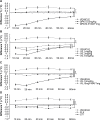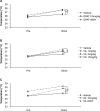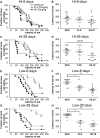5-HT 1A Agonist Properties Contribute to a Robust Response to Vilazodone in the Novelty Suppressed Feeding Paradigm
- PMID: 27352617
- PMCID: PMC5091830
- DOI: 10.1093/ijnp/pyw057
5-HT 1A Agonist Properties Contribute to a Robust Response to Vilazodone in the Novelty Suppressed Feeding Paradigm
Abstract
Background: Differences in 5-HT 1A receptor function have been implicated in vulnerability to depression and in response to treatment. Adding 5-HT 1A partial agonists to selective serotonin reuptake inhibitors has been touted as a strategy to increase their efficacy. Here we use the novelty suppressed feeding paradigm to compare the effects of vilazodone, a high-potency selective serotonin reuptake inhibitor, with high affinity for 5-HT 1A receptors to the reference selective serotonin reuptake inhibitor fluoxetine across several mouse strains that differ in their response to selective serotonin reuptake inhibitors.
Methods: To confirm 5-HT 1A agonist activity, body temperature was measured after acute administration of vilazodone or fluoxetine, as administration of 5-HT 1A agonists induces hypothermia. We next used 3 strains of mice to examine the effects of the drugs on latency in the novelty suppressed feeding, a paradigm generally sensitive to chronic but not acute effects of antidepressants.
Results: Vilazodone induces robust hypothermia and blocks stress-induced hyperthermia in a 5-HT 1A -dependent manner, consistent with agonist effects at 5-HT 1A autoreceptors. In 129SvEv mice, vilazodone (10mg/kg/d) reduces the latency to eat in the novelty suppressed feeding test within 8 days, while no effect of fluoxetine (20mg/kg/d) was detected at that time. In contrast, both vilazodone and fluoxetine are effective at decreasing latency to eat in the novelty suppressed feeding paradigm in a strain with low autoreceptor levels. In mice with higher autoreceptor levels, no significant difference was detected between fluoxetine and vehicle ( P=. 8) or vilazodone and vehicle ( P =.06).
Conclusion: In mice, vilazodone may offer advantages in time of onset and efficacy over a reference selective serotonin reuptake inhibitor in the novelty suppressed feeding test.
Keywords: 5-HT 1A; fluoxetine; novelty suppressed feeding; vilazodone.
© The Author 2016. Published by Oxford University Press on behalf of CINP.
Figures




Similar articles
-
Chronic fluoxetine-induced desensitization of 5-HT1A and 5-HT1B autoreceptors: regional differences and effects of WAY-100635.Eur J Pharmacol. 2004 Feb 13;486(1):25-30. doi: 10.1016/j.ejphar.2003.12.008. Eur J Pharmacol. 2004. PMID: 14751404
-
Effects of systemic injections of vilazodone, a selective serotonin reuptake inhibitor and serotonin 1A receptor agonist, on anxiety induced by predator stress in rats.Eur J Pharmacol. 2004 Nov 3;504(1-2):65-77. doi: 10.1016/j.ejphar.2004.09.009. Eur J Pharmacol. 2004. PMID: 15507223
-
Selective siRNA-mediated suppression of 5-HT1A autoreceptors evokes strong anti-depressant-like effects.Mol Psychiatry. 2012 Jun;17(6):612-23. doi: 10.1038/mp.2011.92. Epub 2011 Aug 2. Mol Psychiatry. 2012. PMID: 21808255
-
Drug evaluation: Vilazodone--a combined SSRI and 5-HT1A partial agonist for the treatment of depression.IDrugs. 2007 Mar;10(3):193-201. IDrugs. 2007. PMID: 17351874 Review.
-
The discovery and development of vilazodone for the treatment of depression: a novel antidepressant or simply another SSRI?Expert Opin Drug Discov. 2013 Dec;8(12):1529-39. doi: 10.1517/17460441.2013.855195. Epub 2013 Nov 7. Expert Opin Drug Discov. 2013. PMID: 24195711 Review.
Cited by
-
Microbial bionic nano-aromatic drugs for prevention of depression induced by chronic stress.J Nanobiotechnology. 2024 Apr 12;22(1):173. doi: 10.1186/s12951-024-02382-y. J Nanobiotechnology. 2024. PMID: 38609944 Free PMC article.
-
The faster-onset antidepressant effects of hypidone hydrochloride (YL-0919).Metab Brain Dis. 2019 Oct;34(5):1375-1384. doi: 10.1007/s11011-019-00439-8. Epub 2019 Jun 24. Metab Brain Dis. 2019. PMID: 31236807
-
5-HT4 Receptors Are Not Involved in the Effects of Fluoxetine in the Corticosterone Model of Depression.ACS Chem Neurosci. 2021 Jun 2;12(11):2036-2044. doi: 10.1021/acschemneuro.1c00158. Epub 2021 May 11. ACS Chem Neurosci. 2021. PMID: 33974408 Free PMC article.
References
-
- Ashby CR, Jr, Kehne JH, Bartoszyk GD, Renda MJ, Athanasiou M, Pierz KA, Seyfried CA. (2013) Electrophysiological evidence for rapid 5-HT(1)A autoreceptor inhibition by vilazodone, a 5-HT(1)A receptor partial agonist and 5-HT reuptake inhibitor. Eur J Pharmacol 714:359–365. - PubMed
-
- Bielski RJ, Cunningham L, Horrigan JP, Londborg PD, Smith WT, Weiss K. (2008) Gepirone extended-release in the treatment of adult outpatients with major depressive disorder: a double-blind, randomized, placebo-controlled, parallel-group study. J Clin Psychiatry 69:571–577. - PubMed
-
- Blier P, Pineyro G, el Mansari M, Bergeron R, de Montigny C. (1998) Role of somatodendritic 5-HT autoreceptors in modulating 5-HT neurotransmission. Ann N Y Acad Sci 861:204–216. - PubMed
-
- Bodnoff SR, Suranyi-Cadotte B, Aitken DH, Quirion R, Meaney MJ. (1988) The effects of chronic antidepressant treatment in an animal model of anxiety. Psychopharmacology 95:298–302. - PubMed
LinkOut - more resources
Full Text Sources
Other Literature Sources

